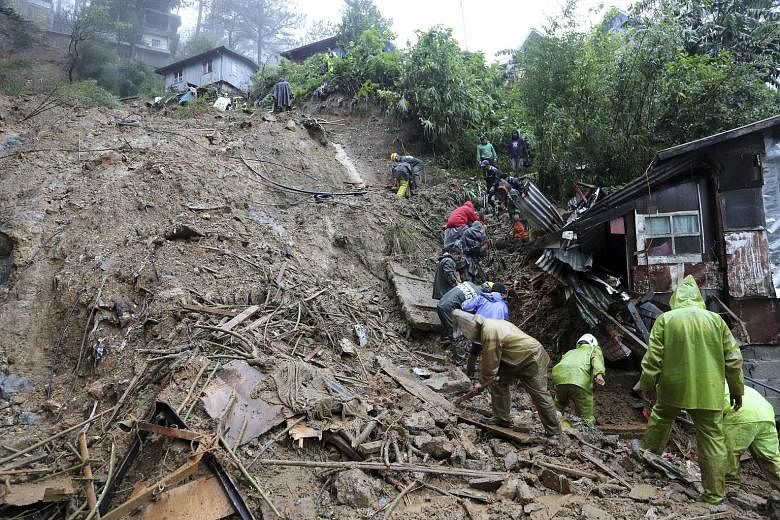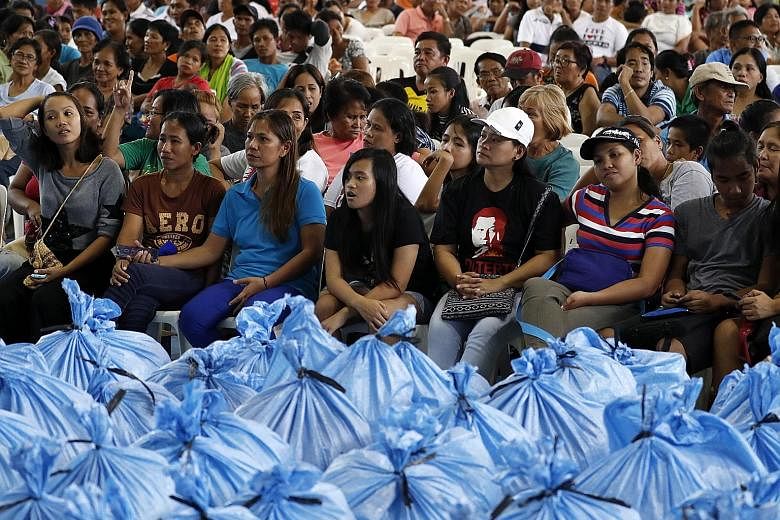CLAVERIA (Philippines) • Typhoon Mangkhut, which meteorologists called the most powerful storm in the world this year, swept through the northern end of the Philippine island of Luzon, leaving scores of people dead and wreaking havoc.
Shattered schools, bare walls of homes stripped of their roofs and vast cornfields drowned in muddy floodwaters were left in the typhoon's wake. Some roads were cut off by landslides and many remained submerged.
Among the casualties was a family of four who were killed when a landslide struck their home in the Cordillera Mountains, south of the town of Claveria, according to Mr Francis Tolentino, an adviser to President Rodrigo Duterte.
Head of the military's Northern Luzon Command Emmanuel Salamat said that at least 19 more were killed in landslides in one part of Benguet province.
According to Mr Tolentino, the 19 who died were part of a bigger group of 43 people, likely miners, and those still alive were feared to be trapped in an old mining bunkhouse that had collapsed under rubble.
Search-and-rescue missions were ongoing, and a local mayor in Benguet, Mr Victorio Palangdan, said he feared the number killed there could be more than 100. Separately, the coast guard said it had recovered the bodies of three people.
Yet, amid the suffering, there was also relief that the situation was not much worse. The initial casualty toll was far lower than officials had feared in the days before the storm made landfall early last Saturday.
"It was not so severe as we expected it to be because earlier it was noted it would be strong," said Mr Duterte, following an aerial survey of some affected areas.
But it could be days or weeks before the storm's true human toll is known. It will also take time to assess how much damage was done to the country's prime agricultural region and to the economy.
Damage to farms could be extensive - and costly for the nation. The region is the country's largest food producer, and the destruction of crops could lead to food shortages, higher costs and inflation. Experts have said the economic losses could reach 6.6 per cent of the Philippines' gross domestic product, or more than US$20 billion (S$27.5 billion).
The authorities said they would offer aid to farmers while planning to airlift vegetables, fruit, poultry and fish from the southern island of Mindanao to augment the food supply in the north.
"We're already poor and then this happened to us. We have lost hope," said 40-year-old Mary Anne Baril, whose corn and rice crops were spoilt. "We have no other means to survive," she said tearfully.
From the road above Mr Robert Tumaneng's fish ponds, the floodwaters extended as far as the eye could see, with the tips of palm trees and the thatched roofs of wooden shacks barely visible.
"It was shaking like an earthquake," said Mr Tumaneng, 55, a fish farmer in Claveria. "This storm was different because the wind was low to the ground like it was crawling and destroying everything."
The number of confirmed fatalities is almost certain to rise as people begin assessing damage from the typhoon. But if the numbers are limited, it will be, at least in part, a testament to the preparedness of the authorities following disastrous storms in recent years.
Determined not to see a repeat of Typhoon Haiyan, which killed more than 6,000 people in the central Philippines in 2013, officials had evacuated more than 105,000 people to temporary shelters before Typhoon Mangkhut hit.
Communications in the disaster zone were hampered by power and mobile service blackouts, and access was difficult in many places because of flooding and road closures, making it hard to evaluate the storm's full effect.
The typhoon, with wind speeds hitting 274kmh before reaching land, could have caused far more damage if it had hit Luzon farther south and closer to Manila - a mega city of more than 12 million people.
The capital was hit by heavy rain and strong winds, with trees uprooted and flooding in some areas.
More than 1,600 families were evacuated after the Marikina River, which runs through part of the city, began rising quickly because of runoff from nearby mountains.
Police said the body of a child, about 10 years old, was found floating in the river.
In Claveria, the Antonio family was one that did not evacuate at first. But at about 1am, when strong winds made them fear for their safety, they moved to the shelter of their in-laws' sturdier home. Mr Marck James Antonio, 24, stayed behind and was struck in the right temple by part of the roof that flew off, leaving a big gash.
"This was the strongest and the worst storm that I've ever experienced in my life," said his mother, Mrs Teresita Antonio, 54. "I was crying because I don't know how I will be able to afford to fix my house."
No rescuers have reached the area yet.
In the town of Sanchez-Mira, 19km east, local officials said they had ensured people's safety by pushing them to take shelter at the community hall.
Eventually, 271 people complied. Some had to be rounded up by police cars.
"Some people didn't want to evacuate their homes but I forced them," said community leader Rewin Valenzuela, 48. "If we didn't make them evacuate, they could have lost their lives. We evacuated everyone to prevent loss of life."
NYTIMES, AGENCE FRANCE-PRESSE, REUTERS


